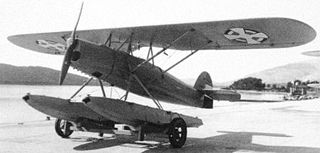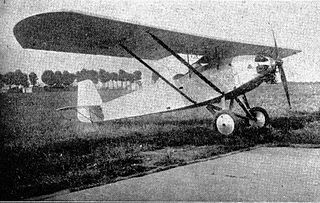 W
WA trainer is a class of aircraft designed specifically to facilitate flight training of pilots and aircrews. The use of a dedicated trainer aircraft with additional safety features—such as tandem flight controls, forgiving flight characteristics and a simplified cockpit arrangement—allows pilots-in-training to safely advance their skills in a more forgiving aircraft.
 W
WThe Fizir F1V was the basis from which engineer Rudolf Fizir developed a series of single-engined, two-seat, reconnaissance biplanes fitted with different engines. Construction was carried out in the Yugoslav aircraft factories Zmaj and Rogožarski between 1928 and 1932.
 W
WThe Ikarus MM-2 was a 1940 prototype single engine low-wing monoplane advanced training aircraft featuring mixed construction and retractable undercarriage produced at the Yugoslavian Ikarus factory.
 W
WA jet trainer is a jet aircraft for use as a trainer, whether for basic or advanced flight training. Jet trainers are either custom designs or modifications of existing aircraft. With the introduction of military jet-powered aircraft towards the end of the World War II it became a requirement to train pilots in the handling of such aircraft.
 W
WThe Leonard glider was an open frame primary glider, available in the standard single seat form or, unusually, as a two-seater. It was marketed in the U.S. in the early 1930s.
 W
WThe Rogožarski AŽR was a single-engined, two-seat biplane aircraft designed as a trainer in Yugoslavia before World War II. It was designed and built at the Rogožarski factory in Belgrade.
 W
WRogožarski Brucoš was a single-engine, two-seat, low wing monoplane aircraft designed as a trainer in Yugoslavia before World War II. It was designed and built in the Rogožarski aircraft factory in Belgrade.
The Rogožarski PVT was a single-engined, two-seat parasol winged aircraft designed as an advanced and fighter trainer in Yugoslavia before World War II. Over 60 were built, serving with the Yugoslav Royal Air Force (YAF) until the fall of Yugoslavia in 1941. After that, some PVTs were used by the newly formed Air Force of the Independent State of Croatia, sometimes as ground attack aircraft.
 W
WThe Rogožarski SIM-VI was a single-engined, two-seat, low wing aircraft designed as trainer in Yugoslav before World War II. It was designed and built at the Rogožarski factory in Belgrade.
 W
WThe SIM-VIII was a 1931 Yugoslav, single-engined, 2-seat, sport, tourist and training aircraft, designed by Sima Milutinović and built at the Rogožarski factory in Belgrade from 1931 and by Ikarus at Zemun from 1933.
 W
WThe Rogožarski SIM-X was a Yugoslav single-engine sports and tourist plane also used for basic training of military pilots designed in 1936, with two crew members. It was designed and built at the Rogožarski factory in Belgrade.
 W
WThe Rogožarski SIM-XI was a single-seat, single-engine trainer monoplane built in the Kingdom of Yugoslavia in 1938. It was designed and built at the Rogožarski factory in Belgrade.
 W
WThe Rogožarski SIM-XII-H was a Yugoslav trainer single-engine floatplane, with two floats designed in 1938. It was designed and built at the Rogožarski factory in Belgrade.
 W
WThe SIM-II was a 1930s Yugoslav Sports and tourist plane and the plane for the basic training, one-engined, with two crew members. It was designed by Sima Milutinović and built at the "S.Vlajković i sinovi" factory in Belgrade.
 W
WThe TAI Hürjet is a proposed single-engine, tandem seat, supersonic advanced trainer and light combat aircraft, under development by Turkish Aerospace Industries (TAI).
 W
WThe Boeing T-5 or Thorp T-5 was a student-built aircraft that was designed by John Thorp for the Boeing School of Aeronautics.
 W
WVL Viima, constructed by the State Aircraft Factory is a Finnish two-seat, biplane trainer used by the Finnish Air Force from the late 1930s to the early 1960s. After military service, several were released into civil use.
 W
WThe Whitney Boomerang DW200 is a two-seat, fixed tricycle gear general aviation airplane, originally designed for flight training, touring and personal use. It can be seen in active service at Darwin International, Brisbane's Archerfield and Perth's Jandakot general aviation airports.
 W
WThe Zmaj Fizir FN was a plane designed for primary (initial) training of pilots in Yugoslavia before World War II. It was constructed in Zmaj, a Zemun-based factory, in the Rogožarski factory in Belgrade, and Albatros in Sremska Mitrovica.
 W
WAircraft Zmaj Fizir FP-2 was a Yugoslav single-engine, two-seater biplane. It was designed by R. Fizir and D. Stankov built at the Factory Zmaj in Zemun in 1936.